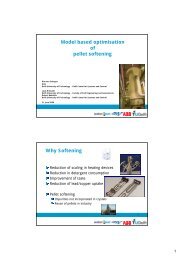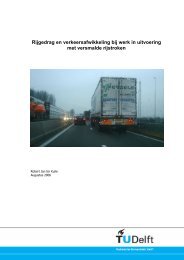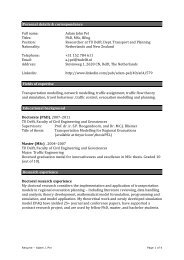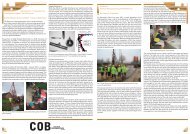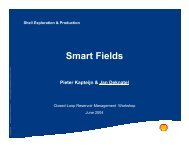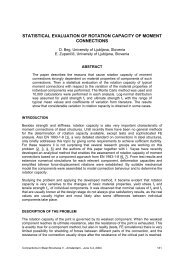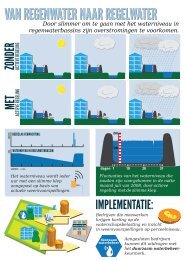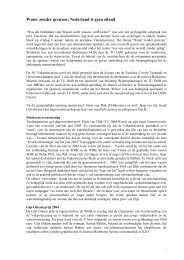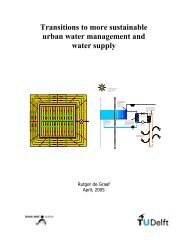Pedestrian route-choice and activity scheduling theory and models
Pedestrian route-choice and activity scheduling theory and models
Pedestrian route-choice and activity scheduling theory and models
You also want an ePaper? Increase the reach of your titles
YUMPU automatically turns print PDFs into web optimized ePapers that Google loves.
S.P. Hoogendoorn, P.H.L. Bovy / Transportation Research Part B 38 (2004) 169–190 171<br />
3. Modeling approaches to pedestrian travel behavior<br />
Queuing <strong>models</strong> (Lovas, 1994) use Markov-chain <strong>models</strong> to described how pedestrians move<br />
from one node of the network (mostly a room) to another. R<strong>and</strong>om waiting times are incurred on<br />
the links, due to queues building up when pedestrian traffic dem<strong>and</strong> is larger than the door capacity.<br />
Queuing <strong>models</strong> have been used mostly to describe pedestrian evacuation behavior from<br />
buildings.<br />
Gipps (1986) <strong>and</strong> Hamacher <strong>and</strong> Tj<strong>and</strong>ra (2001) describe pedestrian <strong>route</strong> <strong>choice</strong> through the<br />
walking facility by determining a finite number of <strong>route</strong>s through the walking infrastructure <strong>and</strong><br />
applying basic discrete <strong>choice</strong> modeling. Similar to the model described in this article, the main<br />
theoretical assumption is that pedestrians make a subjective rational <strong>choice</strong> between alternatives.<br />
Contrary to the model described in this article, the number of <strong>choice</strong> options is finite. Verl<strong>and</strong>er<br />
(1997) estimates discrete <strong>choice</strong> <strong>models</strong> using household-based diary data. Teklenburg et al. (1993)<br />
use a Space Syntax model, which is calibrated using pedestrian flow data.<br />
Notwithst<strong>and</strong>ing the practicality of assuming only a limited number of <strong>route</strong> alternatives, in<br />
real life pedestrians can choose between an infinite (<strong>and</strong> in fact, non-countable) number of <strong>route</strong>s.<br />
Using potential functions, Hughes (2002) accounts for this aspect, by describing the optimal<br />
walking direction to the destination (in terms of travel time) as a function of the current location x<br />
of the pedestrian. However, the approach prohibits including general <strong>route</strong> attributes, such as<br />
walking distance or stimulation of the environment, as well as uncertainty in the traffic conditions<br />
expected by the pedestrians. The research described in this article has succeeded in remedying<br />
these issues, while at the same time establishing a solid theoretical basis for pedestrian <strong>route</strong><strong>choice</strong><br />
<strong>and</strong> <strong>activity</strong> <strong>scheduling</strong>.<br />
4. Normative pedestrian behavior <strong>theory</strong><br />
The main behavioral assumption here, is that all actions of the pedestrian, let it be performing<br />
an <strong>activity</strong> or walking along a certain <strong>route</strong>, will provide utility (or equivalently, induce cost) to<br />
him. The pedestrian will predict <strong>and</strong> optimize this expected utility, taking into account the uncertainty<br />
in the expected traffic conditions (similar to microeconomic consumer <strong>theory</strong>). It is well<br />
known that normative <strong>choice</strong> <strong>theory</strong> will not fully cover real-life human <strong>choice</strong> behavior. It does<br />
however provide a very convenient framework for modeling human decision making (Van Berkum<br />
<strong>and</strong> Van Der Mede, 1993). Moreover, several empirical studies have shown the applicability<br />
of utility-based approaches to pedestrian <strong>route</strong> <strong>choice</strong> (Hill, 1982; Bovy <strong>and</strong> Stern, 1990). Hence,<br />
its use in pedestrian behavior <strong>theory</strong> is justified.<br />
The <strong>theory</strong> presented here differs from discrete <strong>choice</strong> <strong>theory</strong> in a number of ways. First <strong>and</strong><br />
foremost, an infinite number of alternative <strong>route</strong>s is considered. Secondly, the r<strong>and</strong>omness in the<br />
<strong>theory</strong> pertains to the uncertainty in the <strong>route</strong> that can be realised. In stochastic discrete <strong>choice</strong><br />
<strong>theory</strong>, the r<strong>and</strong>omness reflects both the fact that people do not always make the same decisions<br />
under the same circumstances <strong>and</strong> the analystÕs lack of more precise knowledge about individualsÕ<br />
decision processes. Furthermore, discrete <strong>choice</strong> <strong>models</strong> are often used to describe the differences<br />
in observed <strong>choice</strong>s made in a sample of individuals. The <strong>theory</strong> presented here is designed to<br />
describe <strong>choice</strong> behavior of individuals, <strong>and</strong> is there not directly representative for groups of



